
Papilio glaucus, the eastern tiger swallowtail, is a species of butterfly native to eastern North America. It is one of the most familiar butterflies in the eastern United States, ranging north to southern Ontario, Canada, and is common in many different habitats. It flies from spring until fall, during which it produces two to three broods. Adults feed on the nectar of many species of flowers, mostly from those of the families Apocynaceae, Asteraceae, and Fabaceae. P. glaucus has a wingspan measuring 7.9 to 14 cm. The male is yellow with four black "tiger stripes" on each forewing. Females may be either yellow or black, making them dimorphic. The yellow morph is similar to the male, but with a conspicuous band of blue spots along the hindwing, while the dark morph is almost completely black.

The large skipper is a butterfly of the family Hesperiidae.

Grass skippers or banded skippers are butterflies of the subfamily Hesperiinae, part of the skipper family, Hesperiidae. The subfamily was established by Pierre André Latreille in 1809.
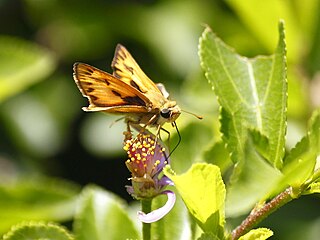
The fiery skipper is a species of butterfly in the family Hesperiidae. Reaching approximately 1 inch (2.5 cm) in length, male fiery skippers are orange or yellow while the females are dark brown. Small brown spots may be observed on both the hindwing and forewing of both sexes although to a varying degree. Females may be darker brown overall with pale checkered markings on the hindwing. Fiery skipper larvae, or caterpillars, are greenish pink-grey with a black head and constricted neck. These larvae are often considered pests and can feed on Bermudagrass, creeping bentgrass, and St. Augustine grass.
Northwest River Natural Area Preserve is a 2,788-acre (11.28 km2) Natural Area Preserve located in the city of Chesapeake, Virginia. Located along the Northwest River, the preserve protects upland forests as well as swamps and marshes along the river.

Carex stricta is a species of sedge known by the common names upright sedge and tussock sedge. The plant grows in moist marshes, forests and alongside bodies of water. It grows up to 2 feet (0.61 m) tall and 2 feet (0.61 m) wide. When the leaves die, they build on top of or around the living plant, making a "tussock". Widely distributed in and east of the Great Plains, it is one of the most common wetland sedges in eastern North America.

Satyrodes eurydice, the eyed brown or marsh eyed brown, is a species of Satyrinae butterfly that is native to North America.

Ancyloxypha numitor, the least skipper, is a North American butterfly in the family Hesperiidae. They have a weak, Satyrinae-like flight.

Polites themistocles, the tawny-edged skipper, is a North American butterfly in the family Hesperiidae.

The Euphyes is genus of North American butterfly of the family Hesperiidae (skippers), subfamily Hesperiinae.

Hesperilla ornata, also known as the spotted skipper or spotted sedge-skipper, is a species of butterfly in the family Hesperiidae. It is found along the non-tropical eastern seaboard of mainland Australia and in the adjacent mountain ranges.
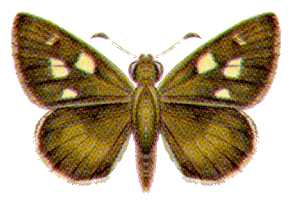
Hesperilla malindeva, commonly known as the malindeva skipper or two-spotted sedge-skipper, is a species of butterfly in the family Hesperiidae. It is found in the Australian states of New South Wales and Queensland.
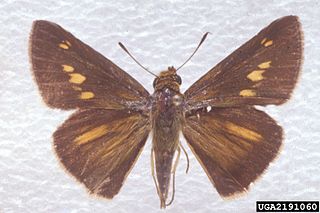
Euphyes dion, the Dion skipper or Alabama skipper, is a species of butterfly of the family Hesperiidae. It is found in scattered populations along the Atlantic coast of North America, from western Massachusetts and south-eastern New York south to north-eastern Florida, west to north-eastern Texas, and north to south-eastern North Dakota, northern Wisconsin, southern Ontario and southern Quebec. It is listed as a species of special concern in the US state of Connecticut.

Euphyes vestris, the dun skipper, sedge witch or dun sedge skipper, is a species of butterfly of the family Hesperiidae. It is found in North America from Nova Scotia west across southern Canada to southern Alberta, south to Florida, the Gulf Coast and eastern Texas. There are disjunct populations in the High Plains and Rocky Mountains and along the Pacific Coast.
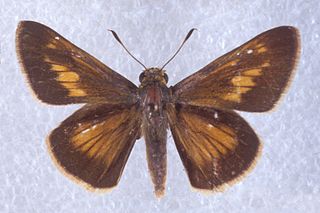
Euphyes pilatka, the Palatka skipper or saw-grass skipper, is a butterfly of the family Hesperiidae. It is found in the United States from southeastern Virginia south to peninsular Florida and the Florida Keys, then west along the Gulf Coast to southern Mississippi. Strays can be found up to northern Maryland and southwestern Louisiana.
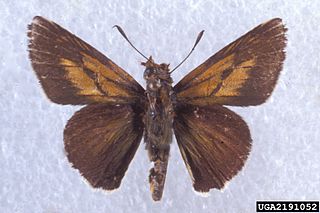
Euphyes arpa, the palmetto skipper, is a butterfly of the family Hesperiidae.
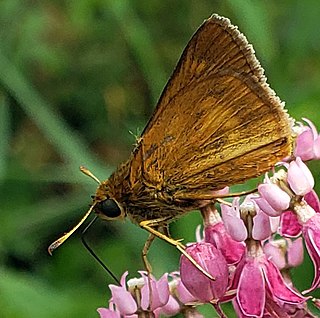
Euphyes conspicua, the black dash, is a butterfly of the family Hesperiidae. The species was first described by William Henry Edwards in 1863. It is found in the upper Midwest of North America, from eastern Nebraska east to southern Ontario and along the central Atlantic Coast from Massachusetts south to south-eastern Virginia. Its habitat includes shrubby or partially wooded wetland.

Euphyes bimacula, the two-spotted skipper, is a butterfly of the family Hesperiidae. It is found in North America, from northeast Colorado and western Nebraska; eastern Nebraska east to southern Quebec; southern Maine south to central Virginia; coastal plain south to Georgia; and the Gulf Coast.
Euphyes berryi, known as Berry's skipper, is a rare species of butterfly of the family Hesperiidae, historically found in wet areas from North Carolina to Florida.

Carex lacustris, known as lake sedge, is a tufted grass-like perennial of the sedge family (Cyperaceae), native to southern Canada and the northern United States. C. lacustris us an herbaceous surface-piercing plant that grows in water up to 50 cm (1.6 ft) deep, and grows 50–150 cm (1.6–4.9 ft) tall. It grows well in marshes and swampy woods of the boreal forest, along river and lake shores, in ditches, marshes, swamps, and other wetland habitat. It grows on muck, sedge peat, wet sand or silt, in filtered or full sunlight.




















